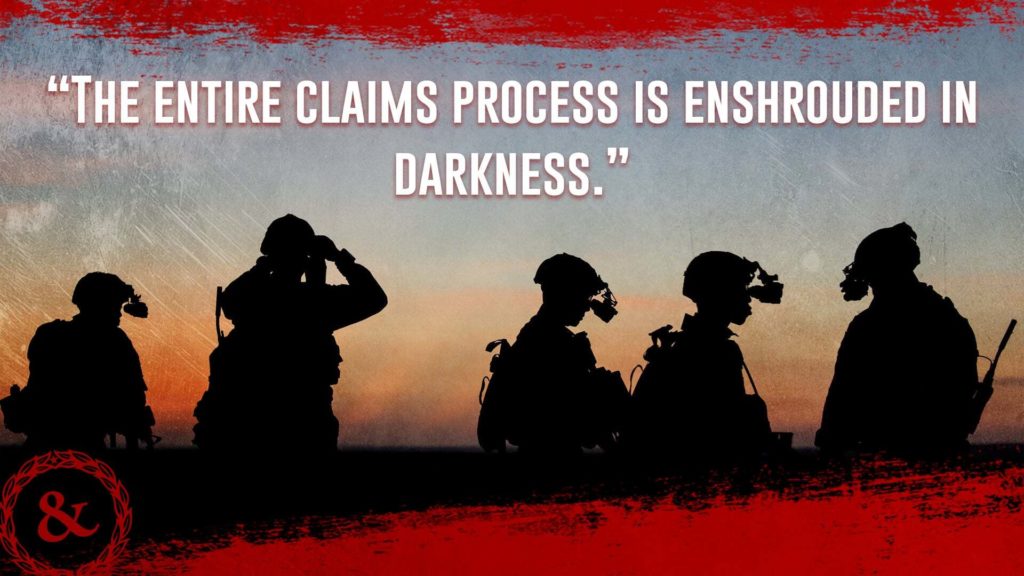Suppose two people visited the same stateside U.S. military hospital at the same time: one a civilian, the other a soldier, and military doctors made the same negligent mistakes in both instances. The civilian patient could sue the military for medical malpractice. The service member could not.
It’s a double standard that every person who has served in the military has lived with for the last 71 years — and they still do today. But for the first time in decades, service members who have suffered due to negligent medical care now have the chance to file a claim against the Department of Defense.
The Pentagon published rules on Thursday laying out how military personnel and their families can submit medical malpractice claims for damages to the government. However, given that the rules on how to file a medical malpractice claim against the military have only now been put into place, it’s difficult to say how this will play out in practice.
Those 57 pages of dense legal jargon are the latest development in a lengthy legal battle, which began in the nation’s highest court in 1950 with Feres v. United States.
The controversial court ruling stems from a case involving the Federal Tort Claims Act, a law that governs how citizens can sue the government for negligence or wrongdoing. In the Feres case, the court dismissed a lawsuit brought by the widow of Army Lt. Rudolph Feres, who died in 1947 when his barracks caught fire due to a defective heating system. The Supreme Court ruled that the federal government could not be held liable “for injuries to members of the armed forces arising from activities incident to military service.”
With that, the Supreme Court established a precedent called the Feres Doctrine, which has been used to bar service members from suing the military over injuries or death that are deemed to be a result of their service.
Justice denied
The reasoning behind the Feres decision was two-fold: A system for compensating military personnel and their families for injury or death exists in the form of disability compensation and life insurance payments; and opening the military to lawsuits might invite second-guessing of command decisions in civilian courts.
But over the last seven decades the legal rule has been broadly applied to a range of instances — from incidents during training, to workplace violence, sexual assault, and medical malpractice — that are far removed from combat.
If you are serving in uniform, and you are harmed or killed due to an act of negligence by a fellow service member, or the incompetence of a commander, the military, and thus the federal government, is not liable.
If you visit your on-base hospital for abdominal pain, and you are repeatedly misdiagnosed as having a hernia when you actually have cancer — as was the case with both Army Sgt. Jeremy Seals and Spc. Carson Thomas — due to the Feres Doctrine, you are barred from suing the government for medical malpractice.
If you are attacked by a coworker after warning your leadership multiple times that your colleague was dangerous — as Army 1st Lt. Katie Blanchard was — the military, to include your command, are safe from the threat of a lawsuit.
If a tumor shows up on a CT scan of your lungs and none of your military medical care providers notice it, and instead send you home with a diagnosis for pneumonia and allergies, and you only find out after you pay out of pocket to see a civilian doctor who catches your stage IV lung cancer immediately, as was the case with Sgt. 1st Class Richard Stayskal, an Army Green Beret — that too is barred by Feres.
Or if a military doctor repeatedly prescribes increasing doses of oxycodone to a patient to treat pain stemming from a shoulder surgery, and those drugs have no effect, and the patient dies of opioid toxicity — as was the case with Navy Petty Officer 3rd Class Jordan Way — then the Feres Doctrine again protects the military from legal action.
In the eyes of the law, each and every one of these examples is considered a risk that comes with serving in the military. If any one of those service members had been a civilian, say a spouse going to the base hospital, then they could have brought a lawsuit against the U.S. military.
Related: A Green Beret describes how the military botched his cancer diagnosis
In addition to barring service members from legal recourse, the Feres Doctrine deprives military personnel of having their day in court. Cases that run afoul of the decades-old law are usually tossed out, if they’re ever taken on by attorneys in the first place. Because it is a legal precedent, the Feres Doctrine can only be changed in one of two ways: Either by taking a lawsuit all the way to the Supreme Court, and getting a reversal on the original ruling, which has yet to happen; or by petitioning Congress to change the law.
That is why, in 2019, after a lengthy and aggressive campaign by service members, veterans, lawyers, lawmakers and advocates, a work-around to the Feres Doctrine made its way into the 2020 National Defense Authorization Act, the bundle of laws that make up the Defense Department’s annual budget.
That bill, named after Stayskal, opened the door for service members to file claims for damages against the military for medical malpractice in certain situations.
However, it wouldn’t happen for another year and a half.
After the National Defense Authorization Act was signed into law by President Donald Trump in December 2019, the military was tasked with figuring out what that process would look like in practice. A little over a year later, in January, Bloomberg Law reported that as many as 227 medical malpractice claims were languishing at the Pentagon while the Department of Defense worked on finalizing the new guidelines.
“Given the importance of the administrative claims process to service members and their families, it was essential to get it right,” Pentagon spokeswoman Lisa Lawrence said.
Righting the wrongs of the Feres Doctrine
While the Defense Department worked on drafting the rules, which were published Thursday, service members — or their surviving family members in the event of wrongful death due to medical malpractice — were able to submit claims, even if they wouldn’t be addressed until that process was finalized. This at least allowed troops or their families to “file claims with their respective military department to ensure they did not fall outside of the required 2-or 3-year window to file their claims,” Lawrence said.
Now, with those rules in place, the process of addressing service members’ medical malpractice claims can begin, but there are concerns that by bringing a claim for damages to the military, service members will lose out on many of the advantages that come from filing a lawsuit in court.
The guidelines, which were determined by the Department of Defense, stipulate that “the adjudication of claims under this authority is not an adversarial proceeding, there is no prevailing party to be awarded costs, and there is no judicial review. The settlement and adjudication of medical malpractice claims of members of the uniformed services is final and conclusive.”
In layman’s terms, what this means is: This is a claims process, and not a court case. As such, it might limit the ability of service members and their families to get answers to what went wrong, who’s to blame, and, as worded, it appears that there is little, if any, room to challenge the military’s final decision in court once the process is complete.
“The entire claims process is enshrouded in darkness,” Dwight Stirling, the CEO of the Center for Law and Military Policy, told Task & Purpose this week. “Due to the vagueness of the rules, claims can be evaluated by nameless officials in secretive offices.”
“Who will be on the panels? What are their qualifications and biases? Did they question the physician’s account of what happened or simply take it at face value?” asked Stirling, a JAG officer in the California National Guard, who testified before Congress on military medical malpractice back in April 2019.
“Congress should never have allowed the rules to be written by the Department of Defense,” Stirling said. “How can letting the agency at fault dictate the process be considered a good idea? In addition, Congress gave DoD officials the power to decide the claims, meaning one powerful colonel will be judging the conduct of another powerful colonel. No one who has spent a day in the military should be comfortable with a system as cozy and inbred as this. The temptation to cover up dirty laundry is too powerful.”
Given that the rules have only now been put in place, it’s hard to know for certain what problems might arise, and should that happen, what recourse victims of military medical malpractice actually have, once the military begins reviewing the claims.
“You hope that they do what’s right, and that the claims will be processed appropriately and that the claims will be comparable,” said attorney Natalie Khawam, the founder and president of Whistleblower Law Firm, which she said has filed as many as 150 claims with the Department of Defense since the law allowing medical malpractice claims was passed in 2019.
“There’s always going to be room for abuse in any system,” she said.
When it comes to challenging the military’s decision on a claim, “right now we don’t know what we can or can’t do,” Khawam said. “If there are issues, we always have Congress.”
How to file a claim
The new rules governing the claims process for medical malpractice will go into effect on July 19. For those seeking to file claims, they will need to be submitted to specific offices for each military branch. (The guidelines for filing medical malpractice claims are included at the bottom of this article.)
Medical malpractice claims must be for injuries that are deemed to be “incident to service,” according to the official notice.
“For members on active duty, almost any injury or illness arising out of medical care received at a [military medical treatment facility] by a DoD health care provider is considered incident to service,” the guidelines say. “Medical care provided to a service member based on military status is incident to service.”
As for those serving in a reserve component, a claim can only be filed if it “is in connection with personal injury or death occurring while the member was in a Federal duty status,” according to the newly released guidelines.
Claims under $100,000 will be paid out directly by the Department of Defense, but those for a higher amount will need to be reviewed, and then disbursed by the Treasury Department.
Even in light of the concerns over the claims process, for those service members and their families who have suffered from military medical malpractice, the guidelines are a victory and, perhaps in some small way, an opportunity for closure.
‘We’ll never know what he would have done on this earth’
For those who have been waiting anxiously for their medical malpractice claims to be reviewed since the law passed in December 2019, some greeted the news with mixed emotions.
“My feelings on this whole matter are: our son passed away wrongly, unjustly,” said Dana Way, the father of Navy Corpsman Jordan Way, who died of opioid toxicity four days after going in for routine shoulder surgery at Naval Hospital Twentynine Palms in California on Dec. 12, 2017.
After Jordan’s death, Dana and Jordan’s mother, Suzi, spent the next several months desperately trying to find out what went wrong, and who was ultimately responsible for their son’s death, only to receive a “slow trickle” of information from the Navy, they previously told Task & Purpose, and a determination that Jordan had died of an opioid overdose.
That finding was eventually re-investigated at the family’s insistence, and the Navy determined that Jordan had in fact died of opioid toxicity. The drugs were providing all the effects except for the one he needed: Pain relief. Despite only meeting with Jordan in person once, his doctor continued to up the dosage, even after the young sailor stated, on multiple occasions, that the drugs were not working.
Over a four-day period, Jordan was prescribed a total of 90 oxycodone pills which increased in dosage from 5 milligrams to 15. At the time of his death on Dec. 16, he had taken 82 pills, typically three at a time every three hours, as prescribed by his military doctor.
Military medical malpractice incidents “are continuing to happen at such regularity that something has to change, so that our boys and girls are suffering from neglect, malpractice, bad management, bad leadership. I want heads to roll about accountability,” Dana said.
“You always hear about it and they definitely hold the younger guys, the enlisted, more accountable than the senior leadership and it should be vice versa,” he added.
For Suzi, Jordan’s mother, the news that there is now some avenue for service members to seek recourse for medical malpractice offered a chance that maybe her son’s death, and her family’s loss, might give something — some small measure of hope or protection — to other service members.
“What is my Jordan’s purpose in life? In his physical form, he only made it to 23 and his life was taken from him,” Suzi told Task & Purpose on Thursday. “We’ll never know what he would have done on this earth.”
“He answered the call to be a Corpsman. He wanted to be a Corpsman so bad. He wanted to answer that call on the battlefield ‘Corpsman up!’”
“So with this struggle — what was Jordan’s purpose? His life had to mean something,” she continued. “I’ve come to the realization, that in his spirit, he is on the battlefield, he is answering that call of ‘Corpsman up.’ His buddies are here on this earth. He hears it, and through his spirit, his life, and his tragedy, he’s coming to their aid.”
Feature image: U.S. Army Soldiers assigned to Viper Company, 1-26 Infantry, 101st Airborne Division (Air Assault), with the East Africa Response Force (EARF), prepare for night vision training at Grand Bara, Djibouti, Dec. 14, 2018. (U.S. Air Force photo by Staff Sgt. Amy Picard.)
The guidelines for service members to submit military medical malpractice claims against the U.S. military can be read below:
Medical Malpractice Claims by Members of the Uniformed Services by James Clark on Scribd

 Call Now- Open 24/7
Call Now- Open 24/7





